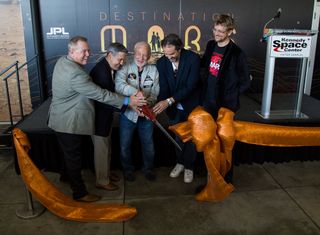'Destination: Mars' Virtual Reality Experience Now Open at Kennedy Space Center

Real-life astronaut Buzz Aldrin introduced his virtual counterpart Sunday (Sept. 18) at the Kennedy Space Center Visitor Complex in Florida, previewing a new "mixed reality" exhibit that lets visitors explore the surface of Mars with a virtual Aldrin as their guide. The exhibit officially opened to the public Monday (Sept. 19) and will be open until the end of the year.
NASA's Jet Propulsion Laboratory (JPL) in California developed the program, called "Destination: Mars," in partnership with Microsoft HoloLens. Visitors use a HoloLens headset, which makes virtual imagery visible on top of the real world, to experience Mars as observed by NASA's Curiosity rover.
Aldrin, who flew on the Apollo 11 mission to the moon, recalled how inspirational the moon landing was for a generation of potential space scientists. Perhaps, he said in a statement, this type of technology could have a similar effect.
"Technology like HoloLens leads us once again toward exploration," Aldrin said. "It's my hope that experiences like 'Destination: Mars' will continue to inspire us to explore."
In the virtual world, Aldrin and Erisa Hines, who drives the real-life rover from JPL, guide viewers through the Martian landscape.

"Destination: Mars" uses software developed at JPL, called OnSight, which lets researchers wearing HoloLens sets participate in a shared virtual reality and plan out routes and points of interest for the Mars rover. Researchers using OnSight could be situated anywhere in the world and interact intuitively with the Martian landscape from the rover's point of view.
Microsoft's HoloLens is not yet commercially available to the public, but visitors to Kennedy Space Center will have a rare opportunity to try out the technology — at least until the exhibit closes, Jan. 1, 2017.
Get the Space.com Newsletter
Breaking space news, the latest updates on rocket launches, skywatching events and more!
Email Sarah Lewin at slewin@space.com or follow her @SarahExplains. Follow us @Spacedotcom, Facebook and Google+. Original article on Space.com.
Join our Space Forums to keep talking space on the latest missions, night sky and more! And if you have a news tip, correction or comment, let us know at: community@space.com.

Sarah Lewin started writing for Space.com in June of 2015 as a Staff Writer and became Associate Editor in 2019 . Her work has been featured by Scientific American, IEEE Spectrum, Quanta Magazine, Wired, The Scientist, Science Friday and WGBH's Inside NOVA. Sarah has an MA from NYU's Science, Health and Environmental Reporting Program and an AB in mathematics from Brown University. When not writing, reading or thinking about space, Sarah enjoys musical theatre and mathematical papercraft. She is currently Assistant News Editor at Scientific American. You can follow her on Twitter @SarahExplains.











